University of Oklahoma
Icons are a form of religious and symbolic painting shared by members of the Orthodox communities in different countries: Greece, Russia, Serbia, Bulgaria, Macedonia and Romania. In this paper, I will consider the common characteristics of the iconic art in the medieval period of all the countries mentioned above. Iconic painting can trace its fundamental technique and presentation to the influence of Byzantine iconic painting.
An icon as a work of art is based on the tension between the visual perception of our terrestrial world and the mysterious world beyond. Religious truths which are rooted in the world beyond our sensory ken are rendered by earthly means: by form, color and light. This sensory image of icons should appear as a copy of the universe beyond our sensory perception, holy and godlike and intended to preserve the unchangeable essence of things. It is what Mircea Eliade calls 'sacred space' which is ..."essentially real space...It is in such space that one has direct contact with the sacred-whether this be materialized in certain objects...or manifested in the hiero-cosmic symbols (the Pillar of the World, the Cosmic Tree, etc.)."[1] The icon is constrained by Christian dogma and has a function within Orthodox Church liturgy as a part of the Orthodox Church Iconostasis, the wall of icons separating the alter section of an Orthodox church form the nave. Icons are not paintings in the usual sense of this word. Paintings with their lines and colors depict the people and events of reality which surround us or as in impressionist and abstract painting they reflect the inner life of an artist in which the relationship between events, objects and colors are deformed to the point of nonrecognition. Icons differ from both realistic, representational art and impressionistic and abstract art by REPRESENTING and not depicting another world. The images on icons are looking at us as we look at them. There is an old Russian family custom of covering icons with a piece of cloth when inappropriate, shameful or dishonest actions are taking place in a room with icons present. Icons are covered or removed from a room where sexual encounters occur. The creator of icons is not an artist in the traditional sense of the word, someone who tries to be daringly original and inventive in such a way as to ensure his prominence in the competitive art world. Icon painters are for the most part anonymous and instead of originality they practice long established conventions.
The aim of iconic painting is to communicate this otherworldly reality to viewers by a system of signs; in this way, iconic painting resembles other communicative systems such as natural languages. The canon of icon painting has a set of definite rules and conventional models which represent a closed communicative system. Different communicative levels may be distinguished which parallel levels in natural languages: the use of color in its distinctive contrasts corresponds to the phonemic distinctive feature level, the shape of figures and objects depicted represent the morphological linguistic level. Spacial and temporal relations in an icon can be separated for analytic purposes from the objects represented and they represent one level which in natural languages would correspond to the syntactic level. Such is the division into the right and left side and high and low side of an icon with each side having a definite semiotic function in definite environments as well as the inverted perspective. This is the basic level of analysis of an elementary semiotic value. Such a level may be compared to the phonological level in natural languages which also deal with the basic level of linguistic analysis. The subject of pictorial or iconic representation forms a higher level as it refers to the meaning of what is being represented and it may be compared to the semantic level in natural languages. In Orthodox iconic painting the method of representation depends on the object represented. The semantically important figures such as Christ and the Virgin Mary occupy the central position and are depicted as immobile compared to other individuals on the icon (The Annunciation, 1).
The bending of the angel's knee is indicative of motion. Motion is also indicated in the position of the angel's hands in 1A. (The Annunciation). The faces of the most important figures are turned toward the viewer and they are less subject to perspective deformations. They are also larger than other persons on an icon. The term semantic syntax is often used here analogous to the term used in linguistic descriptions and relating here to the combination of different semantic signs.
The ideographic representation in iconic painting may be formalized in a way which resembles morphological rules in some natural languages in the world: The multiplicity can be expressed by the repetition of a single characteristic detail, e.g. an army may be depicted with one or two soldiers and a whole complex of helmets following. For example, the battle between the Novgorodians and Suzdal' (2).
This way of indicating multiplicity can be compared to the grammatical method of reduplication indicating plurality similar to the reduplication of the stem in the plural formation in Indonesian: 'kursi'-chair, kursikursi-chairs.[2] On the symbolic level of painting symbolism of color can be examined from different points of view and can be compared to the phraseological level in a natural language as color is a twice removed sign and therefore of an higher order. In other words, color is not a sign by itself; it has to relate to an object or a special arbitrary situation to obtain its full significance.
The semiotic, lingual nature of icon painting was noticed and confirmed by Orthodox church fathers. St. Nilus of Sinai wrote in the fifth century that the icons were placed in churches "so that the illiterate who are unable to read the Holy Scriptures, may, by gazing at the pictures, become mindful of the faith."[3] Pope Gregory the Great expressed the same idea: "What a book is to those who can read, a picture is to the ignorant people who look at it. Because in a picture even the unlearned may see what example they should follow; Because in a picture they who know no letters may yet read."[4]
This concept of otherworldliness to be expressed by visible means necessitated a particular painting style different from the realistic style of verisimilitude used in portraying scenes from this world. From the Christian point of view this world in which we are living is different and inferior to the world beyond and this point of dogma had to be expressed visually in icon painting by violating some of the conventions and rules of realistic verisimilitude painting especially as relates to the concepts of space and time. The eye as part of the corporal world cannot be trusted and what it sees may be misleading as the widely different testimonies of eyewitnesses of the same event may show. Scientists confirm the restrictive range of our eyesight since we are surrounded by the world we cannot see bounded on one side of the spectrum by high frequency colors and on the other by low frequency colors. We will always be removed a few levels from a reality we ultimately can only imagine. Persons at a distance appear smaller than their actual size so our visual image of them does not correspond to their real size. The direct perspective which has been used widely after the Renaissance assumes a viewer who outside the object or the figure viewed from a fixed position sees a receding landscape converging in one point at the end of the horizon. A rectangular table will in the distance have its sides so bent inward that it will assume the form of a trapezoid with its broad base towards the viewer. Such a sense of perspective has been compared to a person who looks outside his open window onto a scene of which he is not a part (fenestra aperta). This relationship between an observer and the object or figure observed is equivalent to the relationship between a subject and an object. In icon painting we have an inverted perspective: objects and figures which are further away appear larger than those close by. The viewer places himself or herself inside the picture. This kind of painting and drawing technique is also characteristic of children whose separateness as an ego and as an observer has not yet been formed. A child who drew a bridge with some figures in front of it, in the foreground, depicting the latter as smaller than the bridge was asked why are the figures smaller than the bridge. Did he know that what is closer to us seems larger? And what is further away smaller? His answer was, "Yes, but actually, you see I am standing on the bridge."[5] The vanishing point is in front of the picture instead of behind it. The relationship between a viewer and an icon in a inverted perspective is closer and more intimate. The saintly figure on the icon confronts the viewer on an equal basis as a subject facing another subject. It is what Jung describes as synchronicity an encounter between a person and an entity which causes intra psychic changes in the former.[6]
Another fact which accentuates the autonomy of icons vis-a-vis viewers is their spacial orientation in terms of left side/right side.[7] It is the mirror image of the left side/right side orientation of a viewer. Our viewer's left side is the icon's right side and the icon's left side is our viewer's right side. It is the spacial orientation of the figure on the icon which determines which side is right and which is left. The opposition rightside/left side plays an important part in the semiotics of icon painting. If goodness and evil are contrasted on an icon, goodness will be located on the right side of an icon and evil will be located on the left or sinister side. The word 'sinister' by itself as well as its figurative equivalents in other European languages implies negativity, ('gauche' in French). We are reminded of the crucifixion depictions where the repentant thief is on Christ's right and on the unrepentant on his left. Devils and scenes depicting hell are invariably located on the left side (Nicholas exorcises the devil, 3):
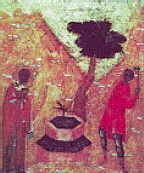
3
In terms of color symbolism the red color of the coat of the person wielding an ax symbolizes blood which is about to be spilled. It is contrasted with the more subdued red coat of the saint. Here we have an opposition between two different shades of red which reinforce the right side/left side opposition. The Russian chronicle describes the conversion of Russians to Christianity in 988 by Prince Vladimir who asked his compatriots to move to the left side if they want to remain pagans and go to hell or move to the right side if they want to join the new religion.[8] It would be interesting to know whether Prince Vladimir referred to his right side or to the right side of the people addressed, that is whether he was facing the crowd or standing in front of it. This scene is reminiscent of the Last Judgement where the just sit on the right side and the damned on the left. If a battle between two armies is presented, the good righteous men will proceed from the right side and the bad men from the left side.(the battle between the Novgorod army and the Susdal army, (2). In the icon of St. George the opposition right/left is neutralized[9] and substituted by the opposition high/low (St. George killing the serpent,(4).
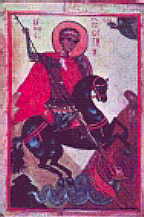
4 St. George killing the serpent
The righteous side is at the top. Motion and time proceed from the right side of the icon to the left. Horsemen start from the right side towards the left and Christ on a donkey follows the right to the left direction. (Christ entering Jerusalem), (5):
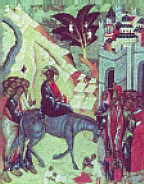
5 Christ entering Jerusalem
So the right side is the East side, the side of the rising sun which is confirmed by commentaries describing individual icons. In the late 17th century, due to Western influences in icon painting under Peter the Great, the determination of which is the right side vs. left side in icons became ambiguous. There was a controversy concerning which side St. Peter and St. Paul were located in relation to Christ. Was St. Peter on the right side or the left side of Christ and the same question related to St Paul (SS Peter and Paul with scenes from their lives, (6).
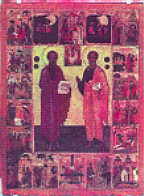
6 SS Peter and Paul
According to the new way of viewing which was oriented toward the outside viewer, St. Peter was on the left side and St Paul on the right side. This was an example of the debasement of iconic traditions in which the right side and the left side were determined by an inner viewer, that is from the viewpoint of Christ. The vertical division of the opposition high/low is used in a similar way as the opposition right side/left side to indicate the opposition of goodness/evil. The low side of the icon is identified with sin, negativity, serpents (as shown in the icon of St. George killing the serpent) and dragons and the high side with goodness. In the narrative icon based on John Climacus's treatise The Ladder of Virtue (7 A, C), a ladder is a Judeo-Christian symbol of the link between heaven and earth.
 7 A |  7 C |
It shows Saint John, as a leader of ascending monks, greeted at the top of the ladder by Christ himself. The ladder, consisting of thirty rungs symbolizing the thirty years of Christ's hidden life, is an allegory of the spiritual life leading from earth to heaven. The earthly condition is the point of departure, the angelic state the goal of arrival. Christ is on the left side which is the wrong side in the opposition right side/left side, goodness/evil, but his image is placed high in the opposition high/low. The opposition right side/left side or goodness/evil is neutralized in favor of the opposition high side/low side, goodness/evil. At the bottom left a choir of monks looks on the drama of virtue. The double opposition right side/left side, goodness/evil and high side/low side, goodness/evil is here neutralized and replaced by the opposition central high/central low. The central high, identified with goodness is symbolized by light coming from the sun and the central low by the low ground populated by devil figures. There are seven of them symbolizing seven deadly sins: superimposed on the above mentioned oppositions is the opposition of ascending saintly figures vs. falling sinners, a dynamic variant of the opposition high side/low side. The ascending saintly figures are slowly climbing while the descending sinners are quickly falling. This quantitative opposition corresponds in linguistics terms to the opposition long/short. The opposition of slowly climbing monks vs. quickly falling sinners in terms of slow rise and quick fall has its linguistic counterpart in the phonemic pitch opposition in Serbian between long rising 'gore' and short falling gore/gore. The semantic opposition of gore/up, upwards and gore/worse applies to the opposition of saintly figures marching up, 'gore' and sinners being in the worse to the 'gore' situation. There is finally a color opposition between devils' black robes and saints' dark red attire. The ladder starts from the right side of the icon and at an incline ends on the left side. Persons at the top of the ladder have spent some time climbing compared to the others who are at the bottom of the ladder. The extent of time spent climbing is indicated by the degree of the ladder incline as the extent of time is projected on the horizontal axis from the right side to the left from the viewpoint of the internal observer. Motion is presented here by climbing, it starts on the right side and proceeds to the left side. Differences in time duration and motion in space are applicable to the terrestrial level only. The opposition in time as long vs. short is neutralized in the heavenly and the underworld levels where only timelessness (eternity) and immobility are present. Devil figures on the left lower side, where they belong, are moving in the opposite direction from left to right. The white background in the upper left side is contrasted with the black in the lower left side. White is often used in the depiction of 'rites of passage' and it is the preferred color for those rites where changes in existence take place on the classic pattern of all initiation, through death and rebirth. Black on the other hand is usually associated with primeval darkness but in the painting below we see that this darkness has a positive meaning. Darkness may signify in different contexts both the end and the beginning of life.[10] Here by way of contrast a ladder scene is shown from a Buddhist painting "The Descent from Heaven" (7 B).
The motion here is descent from the ladder. The roles are also reversed, it is the Buddha, who descends to save humanity with his right hand in a symbolic gesture of preaching the law.[11] The scene is one of jubilation, a much happier scene than The Ladder of Virtue.

7B
The icon, The Ladder of Virtue, (7C) illustrates another characteristic of medieval icon painting, that of perspective distortion.[12] The persons climbing the ladder have turned their faces towards the viewer and not to Christ at whom they should be looking. The full front face presentation or the three quarters or one half face is common in icons regardless of the persons' actual position in space. Profiles are associated with evil or with secondary unimportant figures. To 'translate' this image of ladder climbing persons from the inverted perspective into direct perspective we observe the position of the ladder providing the depth as well as the direction of their bodies which are half turned upward in Christ's direction. It is a clue to what should be the 'real' spacial orientation of the climbers facing Christ. It is often semantically unimportant inanimate objects which undergo the biggest distortion from the point of view of direct perspective and they are the indicators of how an icon should be conceived in the three dimensional space. In direct perspective the ascending climbers will have their backs turned to the viewer in order to face Christ. What we need to do here is analogous to translations from one language to another, from the semantic visual aspect to one of geometric or three dimensional space.
Another example is the Annunciation (1). The faces of Gabriel and Mary are turned to the viewer although in reality they are turned to each other. This is shown by the placement of their bodies, the armchair and the building behind Gabriel. The building immediately behind Gabriel is presented frontally while the upper part is twisted in the lefthand direction reflecting the real position of the two figures. In the icon of Flor and Lavra (8), Flor and Lavra are turned toward the Archangel Michael; this is shown not only by the turn of their bodies but also by the direction of the rocks toward the viewer. Semantically more important figures are presented frontally without or with insignificant perspective distortion. The most important from the semantic point of view are individual faces, followed by bodies and ending with inanimate things.
The representation of the prophets Ezekiel and Avvakum (9) seeing Christ on a Bulgarian icon of the 14th century shows Christ and the two prophets, as semantically important figures, facing the viewer. Also presented frontally is the book lying on the knees of Avvakum as well as the scroll displayed by Christ. The real position in space of prophets facing Christ is indicated by the way the rocks are positioned which provide depth in space between the two prophets and Christ. This is the way the prophets should have been standing looking at Christ in real space, on the rocks with their backs towards the viewer facing Christ.
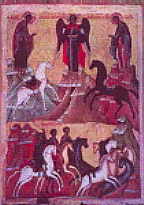 8 Flor and Lavra | 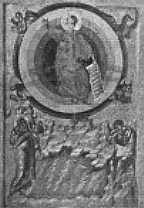 9 Ezekiel and Avvakum |
The two dimensional frontal figures of inverted perspective are not an indication of icon painters' lack of skill. The inverted perspective was a consciously cultivated artistic medium of expression, a different language dominant in the iconography of the Byzantine empire and of the medieval Russian, Bulgarian, Serbian, Ukrainian and Rumanian kingdoms. The transition to the post-renaissance direct perspective medium in icon painting was considered to be a step backward. Thus Protopope Avvakum (1621-1682, the head of Old Believers) was outraged that the representatives of the new school who "paint the image of the Savior, Immanuel, as puffy-faced, with rosy red lips, curly hair, fat arms and muscles, bloated fingers and fat thighs, just like some pot-belied German, all fat, only without a sword at his side. And all this is painted," concludes Avvakum, "in a carnal way, because the heretics are enamored of carnal grossness and have cast the heavens down to the depths,...And all this, that borzoi hound Nikon (Patriarch Nikon 1605-1681), the enemy, intended to paint 'AS If Alive'."[13] (My underlining). Saints dwelling in another world where our notions of space, time and the physical laws of gravity do not apply cannot be painted "As If Alive". All individual physical descriptions of saints are omitted. We can only tell them apart by secondary characteristics-their clothes, by the shape of their beards or the presence of a book in their hands. These secondary characteristics are an iconographic constant present in the depiction of the same saint in icons pertaining to different time periods. I don't think that Avvakum had any anti-German bias but he thought that icons should be painted in an abstract way with idealized human figures defying the terrestrial gravitational pull and faces which are devoid of all attributes of life- flesh, blood and muscle.
Light and color. Light is a traditional religious symbol of spiritual enlightenment and goodness. There are at least a hundred compound words in Orthodox Church language composed of this word: light-bearer, light-giver, light-like, light-manifesting, light-of-light not counting where the word 'light' appears by itself. The lightness/darkness distinction is the starting point of the series set forth in Berlin's Basic Color Terms.[14] This happens to be perceptually the most general of all 'color' experiences. The most important characteristic of the color inventory presented in Basic Color Terms is its universality. From this universal set of colors each culture draws its own subset. Icon painters saw the divine light dwelling in icons and radiating from them without any outside reflected light interfering. The colors in icons do not reflect the relationship of colors and objects in nature. It is an autonomous system of color assumed to be present in the heavenly realm. Gold, like an icon, was considered to be an object radiating light regardless of the influence of the surrounding environment and as such was compared in Byzantine iconography to sunlight and the divine light. Its use in the background of icons symbolizes 'the light not of this world.' No shadows and chiaroscuro exist in the traditionally painted icons. It is as if the giant sun were above the icon figures not allowing any shade to appear. Everything in icons which represents the kingdom of heaven is permeated with light. A shadow is an imperfect and faint representation of a being, an absence of a being and in the ideal and perfect world which icons depict there are only beings and not imitations of beings. In the symbolic tradition, shadows are not only understood as a mere obstructions of light but as dark entities with a nature of their own. In Jung's psychological interpretation, "...human nature is not compounded wholly of light but also abounds in shadows..."[15] By 'shadow' Jung means the unconscious instinctual aspects of human personality which in ordinary individuals are not integrated into consciousness. The absence of the contrast of shadow and light in the depiction of icon figures refers, if we are to follow Jung metaphorically, to individuals who are psychologically fully integrated. The unconscious and the conscious are not apart in them but are one inseparable whole. The icon representing Christ's Transfiguration (10) exemplifies divine light.
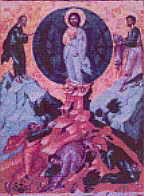
10 Christ's Transfiguration
It emanates from Christ's mandorla (the protective sheath of a divinity which is an almond shape variation of the halo or nimbus and which consists here of two intersecting arcs which surround the entire body) gaining in whiteness as it recedes from its source-a deliberate contravention of terrestrial physical laws which do not apply in the heavenly kingdom. It is a dazzling white which blinds the three disciples who fall to the ground. Origen, the 2nd century Greek writer, commented on this hue of white:" But since there are differences also of things white, his garments become white as the brightest and purest of all white things; and that is light."[16] The normal radiation of light will weaken proportionally to its distance from the source. In this image it becomes stronger, the further it is from its source. The exception here may be due to the teaching of a six century theologian about the primordial divine darkness where God is said to live and which impregnates Christ's mandorla . Another example of emanating light is found in the icons of the Raising of Lazarus (11). It is from once dead Lazarus that the light shines, symbolizing the conquest of death and the enlightenment and illumination of new life.
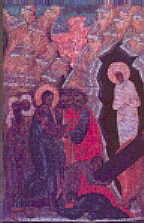
11 Raising of Lazarus
The Orthodox icon painters were very much concerned with luminosity (brightness) and they tend to group colors according to their affinity with light on the one hand and darkness on the other. Their relation to the black/white scale provides their hue. Of three constituents of color: hue, saturation and luminosity (brightness) the use of the latter is particularly prominent in iconic painting. Thus, there are four different luminosities of white and four different words in Byzantine Greek for distinguishing them.[17] On the other hand, Greek words for color are imprecise as they group what we perceive as different hues under the same lexical item. The Greek word for red 'eruthros' ranges in color from 'scarlet' to 'maroon'.[18] When it comes to distinguishing these words it is done by contrasting their relative lightness and darkness. This is one of the reasons why it is difficult to identify a hue both as a signifier and signified ignoring the figure or the object depicted. The white of Christ's robes in the Transfiguration icon, the white of Lazarus's garment and the white of Adam's robe in Anastasis, Christ's descent into hell (12), have different signifieds and there is no common signified for 'white' in all three cases unless we assign them a positive value which is not saying very much. The term often used for the same hue with different signifieds shows their contextual use. 'Blue' is considered by some researchers to be the color of the divine light. According to the Russian painter Kandinsky blue has a solemn superterrestrial gravity.[19] Christ in the fresco in Sopocani (13) is portrayed wearing a blue mantle while in the scene of the angels and sheep at Sant' Appollinare Nuovo (14) it has almost negative connotation depicting the angel with the goats. In the Serbian icon from the Decani monastery in Kosovo, Icon of the Virgin, (15) Christ is wearing close to his body a blue mantle of the solemn superterrestrial gravity to which Kandinsky refers. On top of the mantle is a bright red gown symbolic of blood and Christ's suffering and death. The icon is a good example in the Serbian iconography of the type called "The Virgin with a playing child" by Lazarev[20] or the Virgin having pity (on the mortals). Characteristic of this type of icon is the intimate proximity of the faces and, in this icon, the clasping of hands.
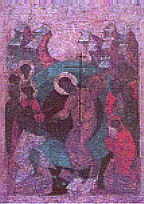 12 Christ's descent into hell | 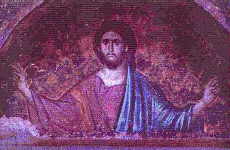 13 Christ (fresco in Sopocani) |
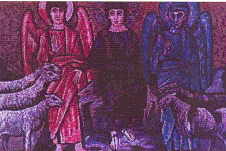 14 Sant' Appollinare Nuovo | 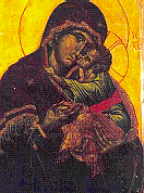 15 The Virgin |
The icon of SS. Sava and Simeon (16) (founder of the Nemanjic dynasty) is located in the Moraca church in the vicinity of Kolasin in Montenegro.
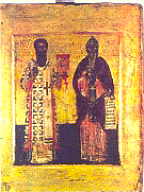
16 SS Sava and Simeon
This type of icon is dynastic, establishing the legitimacy of the dynasty and its consecration by higher powers. St. Sava is to the right of St. Simeon from the viewpoint of the inner observer, the place of honor and intimate relationship. St. Simeon's vestment is dark green, symbolizing regeneration and continuity of the dynasty. This legacy's spiritual aspect is embodied in St. Sava, his son, who wears a vestment of the same color in addition to a pale red gown attesting to his priestly function. The color red is used in church hangings and vestments in masses and in services relating to the Passion, the Apostles and martyrs, and during the week of Pentecost. The Serbian icon of Annunciation (17), in the Church of the Virgin of Perilebtos in Ohrid, dates back to the 14 th century.
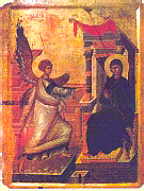
17 Annunciation
Mary's vestment is in dark, somber colors, a foreboding of the grief of her son's sacrificial death. With her left hand (from the viewpoint of the internal observer) she is touching the red edge of her throne, the color symbolic of mortal flesh which will be cast over Christ's divinity. Archangel Gabriel's vestment is silvery, the color which in Christian symbolism stands for Divine Wisdom, as silver is the symbol of purity in all its forms. The Serbian fresco The Nativity (18) is located in the narthex of the Serbian Patriarchate of Pec in Kosovo.
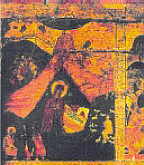
18 The Nativity
It was painted early in the 14th century. Mary's reclining figure appears in the enclosing dark mandorla of a cave, encircled by rocky gold-colored scenery with angels and other figures of the nativity event standing around. The golden yellow rocks emerge from the darkness of the cave background as the yellow earth emerged from the darkness of the primordial chaos.
As an additional example the contrast between white and black (presence/absence or a privative opposition in linguistic terms) is widely used in iconic art to distinguish goodness from evil. Devil figures are invariably black but black is used positively in the portrayal of the primordial darkness of Christ's mandorla. In paraphrasing the color symbolism into language the opposition lightness/darkness, white/black or goodness/evil is in this case neutralized. Black here does not mean evil and it is the source from which white and goodness emerge. The existing opposition can be reformulated as between introvert (black) and extrovert (white) both having the same positive denominator or between hidden and actual. Darkness, according to Jung, is the place of germination and black is the color of origination or impregnation during which seeds germinate before they burst into life and light.
We think of iconic painting as an art, a conscious use of skill and imagination in the production of aesthetic objects. This was not the way icon painting was considered in the medieval period. Skill was necessary, of course, but the main criterion in the evaluation of icons consisted in truthfulness to their prototype, to the saint and the saintly scenes. The icon painting was the holy religious tradition that demanded strict adherence to the canon. Innovation and individuality, which we now consider to be the main criteria of artistic perfection, had no place in icon painting. A comparison can be made here with medieval manuscript writing where the manuscripts had to follow strictly and unconditionally the original. In both cases, more by mistake than by deliberate decision, certain changes were gradually introduced.
[1] Mircea Eliade, Images and Symbols (Princeton: Princeton University Press) 1991, p. 40.
[2]Andreas Koutsoudas, Writing Transformational Grammars (New York: McGraw-Hill) 1966, p.61. "Reduplication is the repetition of the root word, e.g. anak-anak...children" John B. Kwee, Teach Yourself Indonesian (London: The English Universities Press) 1965, p.72.
[3] Boris Uspensky, The Semiotics of the Russian Icon (Lisse:Peter De Ridder) 1976, p. 9.
[4] Boris Uspensky, The Semiotics.... p.10.
[5] Uspensky, The Semiotics....p. 44
[6] Carl Jung, "As its etymology shows, this term has something to do with time or, to be more accurate, with a kind of simultaneity. Instead of simultaneity we could also use the concept of a meaningful coincidence of two or more events, where something other than the probability of chance is involved." Carl Jung, The Portable Jung (New York: Penguin Books) 1981, p. 505.
[7] B. A. Uspensky, "Pravoe i Levoe V Ikonopisnom Izobrazhenii" ![]() in Sbornik Statei Po Vtorichnim Modelirujushchim Sistemam, ed. Ju. Lotman, Tartu 1973 pp. 137-145.
in Sbornik Statei Po Vtorichnim Modelirujushchim Sistemam, ed. Ju. Lotman, Tartu 1973 pp. 137-145.
[8] Under the year 6494. "Volodimer' zhe, v'zd'nuv', reche:"dobro sim' odesnuyu, gore zhe sim' oshyuyu" Povest Vremennykh Let po Lavrent'skoy Letopisi, 1372 (Moskva: Akademiya Nauk) 1950, p.74.
[9]'Neutralization' is a well-known term in phonology. In Russian for example the voiced and voiceless consonants are contrasted in the word initial position: dom/tom while in the final position the opposition is neutralized since the consonants are devoiced: gorod pronounced as /gorot/. "A term used in phonology to describe what happens when the distinction is lost in particular environment." David Crystal, A Dictionary of Linguistics and Phonetics (New York: Basil Blackwell) 1985, p.206.
[10]"Nevertheless it must be said that this gloomy list of associations with the color black is not wholly negative. As well as being the image of death, earth, burial and the mystics' 'dark night of the soul' black is also connected with the promise of the renewal of life, just as darkness holds the promise of dawn and Winter of Spring." Jean Chevalier and Alain Gheerbrant, The Penguin Dictionary of Symbols (New York: 1996) p. 96. According to Pseudo-Dionysius, the most frequently cited theologian of the early Middle Ages:" "Thus one must ascribe non-logos to that beyond logos, non-completion to that beyond completion and before completion; and in terms of a preeminence of visible light, one must ascribe non-manifest and invisible darkness to the inaccessible light." Pseudo- Dionysius Areopagite, The Divine Names and Mystical Theology, On the Divine Names, (Milwaukee,Wisconsin: Marquette University Press, John Jones, editor and translator) p.177. and in a letter,"...The darkness of God which lies beyond light is hidden to light and veiled to knowledge" Letter I to Gaius, a servant of God, Ibid. P.225.
[11] The threefold ladder symbolizes the three cardinal constituents of the Buddhist religion: The Teacher (Buddha), The Teaching and The Community of Believers. The descent of the Buddha to the earth signifies that liberation (enlightenment) is possible in this life and in this world.
[12] See Florenskij P.A. "Obratnaja perspektiva" ![]() Trudy po znakovym sistemam, III (Uchenye zapiski Tartuskogo gos. Universiteta, 198), 381-416,Tartu, 1967.
Trudy po znakovym sistemam, III (Uchenye zapiski Tartuskogo gos. Universiteta, 198), 381-416,Tartu, 1967.
[13] See the conversation "Ob ikonnom pisanii" ![]() in Protopope Avvakum's Knjiga Besed in Pamjatniki istorii staroobrjadchestva, ed. Ja. I.Barskov and P.S. Smirnov, Bk. I,pt. I (Leningrad,1927), col. 282- 83.
in Protopope Avvakum's Knjiga Besed in Pamjatniki istorii staroobrjadchestva, ed. Ja. I.Barskov and P.S. Smirnov, Bk. I,pt. I (Leningrad,1927), col. 282- 83.
[14] Brent Berlin, Basic Color Terms; Their Universality and Evolution (Berkeley: University of California Press) 1969.
[15] Carl G. Jung, The Portable Jung, Chapter II Phenomena Resulting from the Assimilation of the Unconscious (New York: Penguin Books) 1981, p.86
[16] Origen's Commentary on Matthew in Allan Menzies, editor, The Ante-Nicene Fathers, Translations of the Fathers down to A.D. 325 (New York: Charles Scribner's Sons) 1926, vol. IX, p.470.
[17] Liz James, Light and Colour in Byzantine Art (Oxford: Clarendon Press) 1996, p.51.
[18] Liz James, Light and Colour... p.p. 73-74.
[19] "The deeper the blue becomes, the more strongly it calls man toward the infinite, awakening in him a desire for the pure and, finally, for the supernatural. It is the color of the heavens, the same color we picture to ourselves when we hear the sound of the word 'heaven'" Kenneth C. Lindsay and Peter Vergo, Kandinsky, Complete Writings on Art, Volume One (1901- 1921) (Boston: G.K. Hall & Co.) 1982, p. 181.
[20] Viktor N. Lazarev, "Studies in the Iconography of the Virgin" Art Bulletin 20 (1938), pp.42-46.
![]()